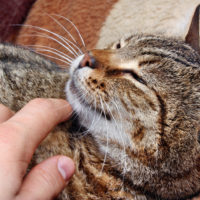Cat aggression during petting can be quite confusing for cat owners. Initially the cat may solicit your touch and may purr or rub herself against you and then at some point during petting, the cat becomes agitated and lashes out.
Repetitive touching can quickly become an annoyance for cats. Dubbed the “go-away bite” by Veterinary Behaviorist, Dr. Debra Horowitz, what appears to be happening is that for a period of time the cat enjoys the interaction, but at some point the physical sensation of being stroked is no longer pleasant. The cat then endeavors to change the situation by presenting an aggressive outburst.
Predicting Cat Aggression During Petting
Cats typically show signs of agitation before they bite. While every cat is different, typical signs include stiffening of the body, flattening of the ears, and twitching of the tail. For most cats, the lashing tail is their final warning and indicates that a bite is imminent if the petting does not stop. Other signs include the cat moving away from you or staring intently at your hand. Knowing how to read your cat’s body language enables you to understand her state of mind and predict her behavior so that you can stop petting before her agitation is expressed as a bite.
Preventing a Cat Bite
Rule Out Pain as a Cause for Cat Aggression During Petting
Petting-induced aggression can also be caused by pain. If your cat is hurting, she will likely lash out at anyone who touches her – the same way you would if you were in pain. It’s a good idea to have your veterinarian examine your cat to rule out pain as an indicator for petting induced aggression.
What Not to Do:
DON’T punish your cat for petting-induced aggression! Especially do not swat her nose or anywhere else on her body. Do not yell at her or forcefully throw her off of you. Cats do not learn that they’ve made a mistake through these methods. You’ll only teach your cat not to trust you at best – and at worst, her aggression will increase.
What To Do: Change your cat’s perception of touch
Repeat these steps multiple times until your cat understands that petting equals yummy food and the yummy food stops when petting stops. As she gets accustomed to touch, you can back off the treats. With time and practice, this process will change how your cat feels about touch.
Getting Help
Assuming that your veterinarian has already ruled out pain as a contributing factor, you can systematically discourage your cat’s petting-induced aggression by respecting her touch tolerance and teaching her that touch is both safe and rewarding. Contact a cat trainer or animal behaviorist in your area to obtain a detailed plan and in-home consultation. Cat training is a specialty; if there are no professionals in your area, many out of area professionals are available for telephone and video consultations.
Additional tips
- When petting, avoid physical restraint as this can increase the cat’s anxiety. An arm innocently draped over the cat or two hands on a cat at the same time may make some cats feel trapped. Additionally, try to avoid petting the cat if she is in a physical position that may make her feel like she is being restrained, such as if she’s spooning with you on the couch or bed.
- Unlike dogs, cats do not like to play rough and most will react negatively to having their fur rustled up, repetitive patting motions or swift, circular rubbing strokes. When touching your cat, strive to use soft, elongated finger-strokes instead.
The hardest part of dealing with petting-induced aggression is accepting that your cat has limits to what she will tolerate. Your cat may never be the cuddly cat that you want her to be, but she can learn to interact with you without biting.
Angel Wasserman, CCBC, CPDT
Certified Behavior Consultant-Canine
Paws in Training, Inc.
(919) 896-2859
angel@pawsintraining.com
www.pawsintraining.com
This article was reposted from the Paws in Training website. Find Paws in Training on Facebook, Google+ and Yelp. Check out Woof It Up! A Guide To Happy Dogs and Happy Owners, available in paperback or E-Book formats.


